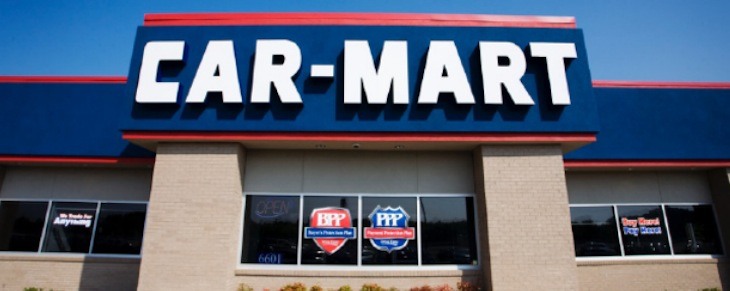Car-Mart could invest millions into business with corporate tax cut
by November 15, 2017 12:32 pm 426 views

America’s Car-Mart looks to not only benefit from an improving used car market but also from the recently proposed tax reform. The Bentonville-based buy here, pay here used car dealership is expected to report second-quarter earnings Thursday (Nov. 16).
“Tax reform will be positive for us,” said Jeff Williams, president and chief financial officer for Car-Mart. “It will allow us to invest more in our business, especially in our people. Our business is high touch, customer service intense and every day is a game day for us.
“Attracting, training and retaining skilled, highly motivated associates is our number one focus, and tax reform will certainly help in a big way as we move forward.”
If approved, the tax proposal U.S. legislators recently introduced would reduce the corporate tax rate to 20%, from 35%. For the quarter that ended July 31, the effective income tax rate was 35.8%, down from 37.3% for the same quarter in 2016, according to a filing with the U.S. Securities and Exchange Commission.
“The rate reduction would result in several million dollars per year that we can invest in our business, and we are very excited about the prospects of tax reform,” Williams said. “Any time we can invest more money in our business and especially our people our customers will see a direct benefit from better service top to bottom. Our customers need us servicing them at the very highest levels always.”
On Thursday, House Republicans plan to vote on their tax reform bill.
Also on Thursday, Car-Mart is expected to report earnings will rise to 79 cents in the quarter ending Oct. 31, from 62 cents in the same quarter in 2016, according to a consensus of four analysts. Revenue is expected to rise 1% to $151.85 million, from $150.21 million.
Shares of Car-Mart (NASDAQ: CRMT) closed at $43.25, up 20 cents or 0.46% on Tuesday (Nov. 14). In the past 52 weeks, the stock has ranged between $47.75 and $30.20.
Earlier this year, many expected used car prices to fall as a large number of leased vehicles hit the market. While the number of leased vehicles hitting the market has risen, it has absorbed them so far with little issue. In 2017, the number of vehicles to come off lease is expected to rise 9% to 3.5 million units, from 3.2 million in 2016, according to Edmunds’ Used Car Market Quarterly Report.
In October, the Manheim Used Vehicle Value Index rose 8.1% to 136.3, from the same month in 2016, and reached a record high for the sixth consecutive month, according to Manheim. The wholesale market continues to show strength “as a result of growing retail demand,” but the majority of the strength in wholesale used vehicle prices “can be attributed to the recovery following Hurricane Harvey and Hurricane Irma.” Replacement demand and a decline in supply has led wholesale inventories to tighten.
“The impact to the wholesale market was widespread, resulting in abnormal wholesale price gains for another month,” according to Manheim.
In October, used vehicle sales rose 3%, from the same month in 2016, according to Cox Automotive. The seasonally adjusted annual rate of sales fell to 39.7 million in October, from 41 million in September. “The retail growth in used sales is coming from vehicles less than four years old, which have grown 14% year-over-year, year-to-date.” These vehicles represent the largest age segment of vehicles in the used car market.
The percentage of these vehicles sold as a share of all used car vehicles has risen 28% to 59.4% in the third quarter of 2017, from 46.3% in the third quarter of 2012, according to the Edmunds report. Over the same period, the average miles on used vehicles sold has declined 14% to 52,648, from 61,330. “These newer, low-mileage vehicles carry the highest price tags that represent the upper corner of the price spectrum, with pricing that rivals that of new vehicles.”
In October, sales of new vehicles fell 1%, from the same month in 2016, according to Manheim. “Relative to earlier in 2017, the performance was impressive.” Two consecutive months of seasonally adjusted annual rate of sales of 18 million “beat expectations and are fueling a strong finish to 2017.” New vehicle inventories were less than 4 million units but were up from September.
In November, 93% of U.S. motorists expect to drive the same or more than they did in the past 30 days, and, “Thanksgiving traffic could be heavy,” according to the Association for Convenience & Fuel Retailing. The organization, which represents the convenience store industry, recently conducted a survey of motorists who purchase fuel at least once a month. In the survey, 61% of consumers were optimistic about the economy, and 75% said gas prices affect their views of the economy.
“Steady gas prices and high levels of economic optimism are great signs for convenience stores heading into the holidays,” said Jeff Lenard, vice president of strategic industry initiatives for the organization. “Convenience stores expect strong sales for fuel, food and drinks from now through the end of the year.”
The U.S. average price for a regular gallon of gas has risen 9 cents to $2.56, from $2.47 a month ago, according to the AAA. In Arkansas, the price has risen 10 cents to $2.31, from $2.21 one month ago.
